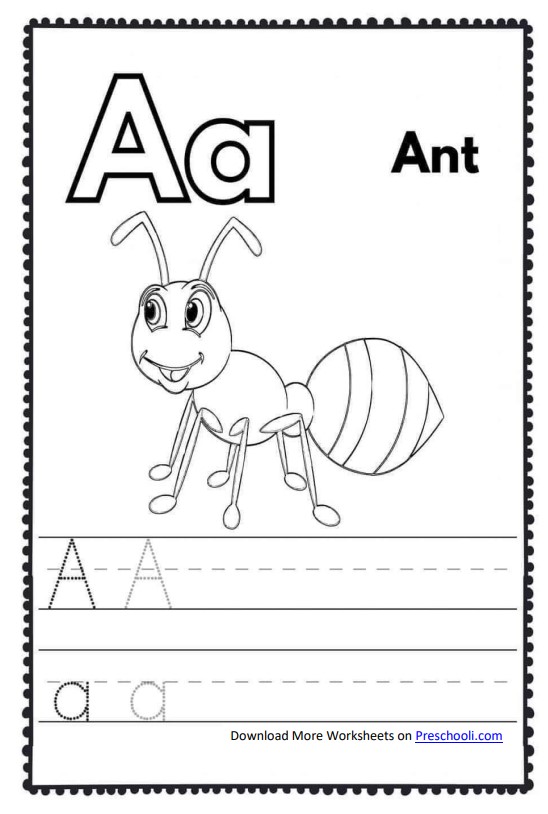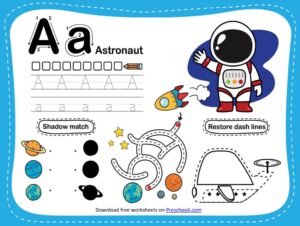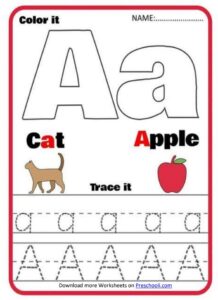Letter Recognition Made Fun: Supercharging Your Preschooler’s Learning with letter recognition worksheets
Preschool learning is such a pivotal time in a child’s education. It’s their grand entrance into the world of letter recognition worksheets, where familiar squiggly lines steadily transform into gateways of creativity. But along the way, helping preschoolers with letter recognition can sometimes feel like rocket science for parents and teachers who’ve been out of kindergarten for a while.
Unbeknownst to many, the humble letter recognition worksheet can be the hero that lights up the ‘Aha!’ moments in young minds. If you’re navigating the waters of preschool learning — whether you’re a homeschooling parent, educator, or looking for engaging activities for your daycare center — it’s time to uncover the potential of letter recognition worksheets.
In this comprehensive guide, we’ll explore the essence of letter recognition, why it’s crucial for your preschooler, and how worksheets can be your ally on this early literacy adventure. Buckle up; we’re about to transform learning the alphabet into a joyous voyage for both you and your little one.
What is Letter Recognition and Why Does it Matter?
Before we start peeking under the hood of the worksheets themselves, it’s important to appreciate the ‘what’ and ‘why’ of letter recognition. Put simply, it is the ability of a child to visually identify and name letters of the alphabet. This skill is part of the essential groundwork for reading and writing.
The significance of letter recognition lies in its direct link to the later literacy skills of your child. It’s one of the earliest building blocks that paves the way for the complex task of learning to read. A strong foundation in letter recognition allows children to distinguish sounds, understand word formation, and ultimately comprehend the written word.
The Playbook of Letter Recognition Worksheets
Now that we understand why letter recognition is a Big Deal, it’s time to dissect the play-by-play of how worksheets can enhance this learning process.
Making It Relevant
Worksheets are most effective when they resonate with a child’s interests and environment. This could mean choosing worksheets that include letters from your child’s name, favorite foods, or cartoon characters. The more personal the content, the more invested your child will be in the learning task.
Multi-sensory Engagement
Effective learning often involves multiple senses. Worksheets that encourage tracing, coloring, cutting, and pasting associate tactile and visual cues to the act of recognizing letters. These activities embed learning through muscle memory and visual association, which can lead to greater retention.
Durability and Repetition
Using laminated worksheets or those placed in sheet protectors allows them to be reused, reinforcing letter recognition through repetition. For some children, repetition is key, and the ability to revisit the same worksheet can solidify their grasp of letters in a familiar context.
Overcoming Challenges with Letter Recognition
Every child’s learning path is unique, and some may struggle more with letter recognition than others. Worksheets can be tailored to address these challenges in a supportive and non-intrusive way.
Differentiation
Differentiation in worksheets means they can be customized with varying levels of difficulty. For children struggling with letter recognition, beginning with simpler exercises that focus on one letter at a time can build confidence before moving on to more complex activities.
Include Tools and Visual Aids
Incorporating letter manipulation tools and visual aids onto worksheets can be incredibly helpful. This could be as straightforward as providing letter magnets or a letter chart, introducing an interactive element that makes learning more tangible and enjoyable.
Stay Positive and Patient
Patience and positive reinforcement are always the best tools in a teacher’s arsenal. Encourage your child’s progress, no matter how small, and remember that the ultimate goal is a love for learning and not breaking land speed records to academic achievements
From the Keyboard to the Coloring Page
Can digital letters teach letter recognition as effectively as physical ones? The ongoing debate between software and worksheets rages on, but the solution might be a balanced approach.
The Digital Dimension
There’s no denying the allure of technology, especially for young, digital natives. Digital letter recognition games and apps can be vibrant and interactive, offering instant feedback that can boost engagement and entertainment value.
Going Analog
Yet, the tactile process of handling physical worksheets, crayons, and scissors provides a dimension of learning that is unparalleled. The tactile engagement with letters aids in the understanding and recognition process in a way that screens can’t replicate.
Cultivating the Right Environment for Letter Recognition Learning
The learning environment plays a crucial role in how effectively worksheets — or any learning tool, for that matter — can impact a child’s letter recognition abilities.
The Power of Routine
Having a consistent time, such as part of the daily routine, designated for letter recognition practice helps children know what to expect and when to be prepared to learn. Predictability and structure help them feel secure and make the learning more effective.
Eliminating Distractions
In a world buzzing with distractions, creating a quiet, focused environment for learning is essential. Turn off the TV, put the phone on silent, and create a dedicated learning space where your child can concentrate and absorb new information without interruption.
Rewarding Effort
Positive reinforcement, rewards, and praise can transform the learning environment into a supportive ecosystem. A simple sticker chart or a special treat for completing worksheets can motivate your child and make learning fun and rewarding
A Parent and Teacher’s Ultimate Guide to Letter Recognition Worksheets
Parent or teacher, in the world of preschool learning, you can be both the coach and the cheerleader. Empower yourself with some key strategies to make letter recognition worksheets an integral part of your child’s learning experience
Building a Toolkit
Having a toolkit of strategies at your disposal can make the worksheet learning more versatile. From using simple flashcards to more intricate interactive worksheets, having options means you can tailor the approach to your child’s current needs and interests.
Monitoring Progress
Be observant of your child’s engagement and progress. If they’re breezing through certain sets of letters, perhaps it’s time to introduce more challenging worksheets. On the flip side, if they’re struggling with specific letters, it’s a signal to reinforce those with dedicated practice.
Engaging in Conversations
Encouraging your child to talk about the letters they’re learning can add yet another layer of learning. Discuss the sounds they make, the words they’re a part of, and any everyday objects that start with the letter.
Case Studies and Success Stories
In education, results matter, and it’s time to share inspiring anecdotes from the front lines of helping children master letter recognition.
The Power of Worksheets in Action
Parents and teachers worldwide have witnessed the transformation of once-puzzled preschoolers into confident young scholars, thanks to well-designed worksheets. These tools have not just helped children recognize letters but have instilled in them a lifelong love for learning.
Learning Through Play and Worksheets
Mixing playtime with worksheet activities can blur the lines between ‘work’ and ‘play’ for children. From alphabet scavenger hunts to letter-themed arts and crafts, the integration of worksheets can be seamless and joyful.
The Letter of the Law: Tips on Making the Most of Worksheets
Before we wrap up this comprehensive exploration of letter recognition worksheets, here are some rapid-fire tips to ensure you get the most out of every worksheet session.
Consistency is Key
Regular practice — even just 10-15 minutes a day — goes a long way. Short, consistent bursts of learning are often more effective than longer, sporadic sessions.
Variety Keeps It Fresh
No one likes monotony, and that goes for preschoolers and their learning materials, too. Switch up the types of worksheets and activities to keep things interesting and exciting.
Celebrate Milestones
Every step forward is a success worth celebrating. Whether it’s your child mastering their ABCs or simply showing improved focus during learning sessions, acknowledge and celebrate their growth.
Closing the Workbook, Opening the Mind
From this deep-dive into letter recognition worksheets, it’s evident how these simple tools can pack such a powerful punch in a child’s early literacy development.
Remember, every worksheet session is not just about recognizing letters; it’s about fostering a love for learning, building confidence, and igniting curiosity. The ABCs are more than just the first 26 letters your child will recognize; they form the foundation for a lifetime of exploration and understanding.
Preschooler learning is an adventure, and you are the guide. With the right tools, a sprinkle of patience, and an endless supply of support, you’re not just teaching letters — you’re opening up a world of possibilities. Happy worksheet weaving!
Join our Facebook Group



